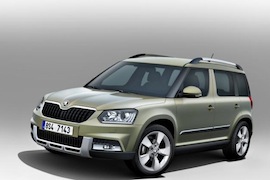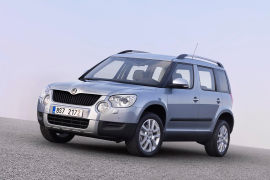SKODA Yeti Models/Series Timeline, Specifications & Photos
First production year: 2009
Engines: Gasoline, Diesel
Body style: SUV (Sports Utility Vehicle)
Skoda refreshed the Yeti range in 2013, drastically improving its look and upgrading its engines to the new European pollution standards.
The introduction of the European pollution standards Euro 5b in January 2013 forced more carmakers to improve their vehicles. It wasn't just about the engine emissions anymore. It was also about safety systems and car recycling factor. Skoda had to improve the Yeti anyway after four years on the market, and it was rather a makeover than just a make-up.
While its predecessor featured distinct fog-lights encircled into a separate cluster next to the headlights, the 2013 Yeti showed-up with a completely new front fascia. Their cubist-style design theme with rectangular headlights and a pronounced look for its underbody shield offered a crossover a bolder stance. Its blackened C-pillar and door frame made the car look like a pickup with a longer window panel. In the rear, the Czech carmaker redesigned the taillights with clear lines that formed a C-letter, from "Clever."
Inside, the Yeti featured small upgrades on the dashboard, and a new steering wheel with more buttons and a hollow lower spoke (depending on the trim level). Due to the new infotainment system, the car could have been fitted with a rearview camera.
Four diesel and three gasoline engines were chosen for the 2013 Skoda Yeti - all turbocharged and with direct injection. The performance spectrum ranged from a 1.2 TSI with 105 hp to a 2.0 TDI with 170 hp. The fifth-generation front- or all-wheel drive with Haldex coupling was fitted depending on the engine specs.
SKODA Yeti 1.2L TSI FWD 6MT (105 HP)
SKODA Yeti 1.2L TSI FWD 6MT (110 HP)
SKODA Yeti 1.2L TSI FWD 7AT (105 HP)
SKODA Yeti 1.2L TSI FWD 7AT (110 HP)
SKODA Yeti 1.4 TSI FWD 7AT (125 HP)
SKODA Yeti 1.4L TSI 4x4 6AT (125 HP)
SKODA Yeti 1.4L TSI 4x4 6MT (125 HP)
SKODA Yeti 1.4L TSI 4x4 6MT (150 HP)
SKODA Yeti 1.4L TSI FWD 6AT (150 HP)
SKODA Yeti 1.6L TDI 4x4 5MT (105 HP)
SKODA Yeti 1.6L TDI GreenLine II FWD 5MT (105 HP)
SKODA Yeti 2.0L TDI 4x4 5MT (110 HP)
SKODA Yeti 2.0L TDI 4x4 6AT (140 HP)
SKODA Yeti 2.0L TDI 4x4 6AT (140 HP)
SKODA Yeti 2.0L TDI 4x4 6AT (170 HP)
SKODA Yeti 2.0L TDI 4x4 6MT (140 HP)
SKODA Yeti 2.0L TDI 4x4 6MT (150 HP)
SKODA Yeti 2.0L TDI 4x4 6MT (170 HP)
SKODA Yeti 2.0L TDI FWD 5MT (110 HP)
SKODA Yeti 2.0L TDI FWD 6AT (150 HP)
Skoda dared for more and introduced the Yeti on the market in 2009 as its first attempt to enter the SUV segment. But it was just bad timing.
The world financial crisis was not over yet, but the Czech carmaker couldn't wait for that to end. So its parent company, Volkswagen, ordered them to launch the Yeti. This vehicle was showcased as a concept car in 2005. It was one of the most practical vehicles on the European market. Moreover, it marked the automaker's entry into the SUV segment, where it wasn't before.
Skoda built the Yeti on the same platform as the Volkswagen Golf. Still, its design resembled the Roomster and the Fabia. At the front, the inward-mounted fog lamps created a unique look for the Czech vehicle. In addition, the steep windshield was needed to create a tall greenhouse, while at the back, the car featured a wide vertical tailgate.
Inside, it didn't need any badges to show its Volkswagen connection. But unlike many other VW products, it showed a clever interior. There were plenty of storage areas: on top of the center stack, in the glove compartment, between the front seats, and even under the high-mounted front bucket seats. At the back, the sliding bench fit for three offered the unusual option for a vehicle in that class to tilt, tumble, or remove the entire bench in parts or entirely.
Under the hood, the carmaker offered a wide engine range, gasoline, and turbo-diesel, paired with a manual or an automatic transmission. Depending on the version, the Yeti was available with a front- or an all-wheel drive system.

